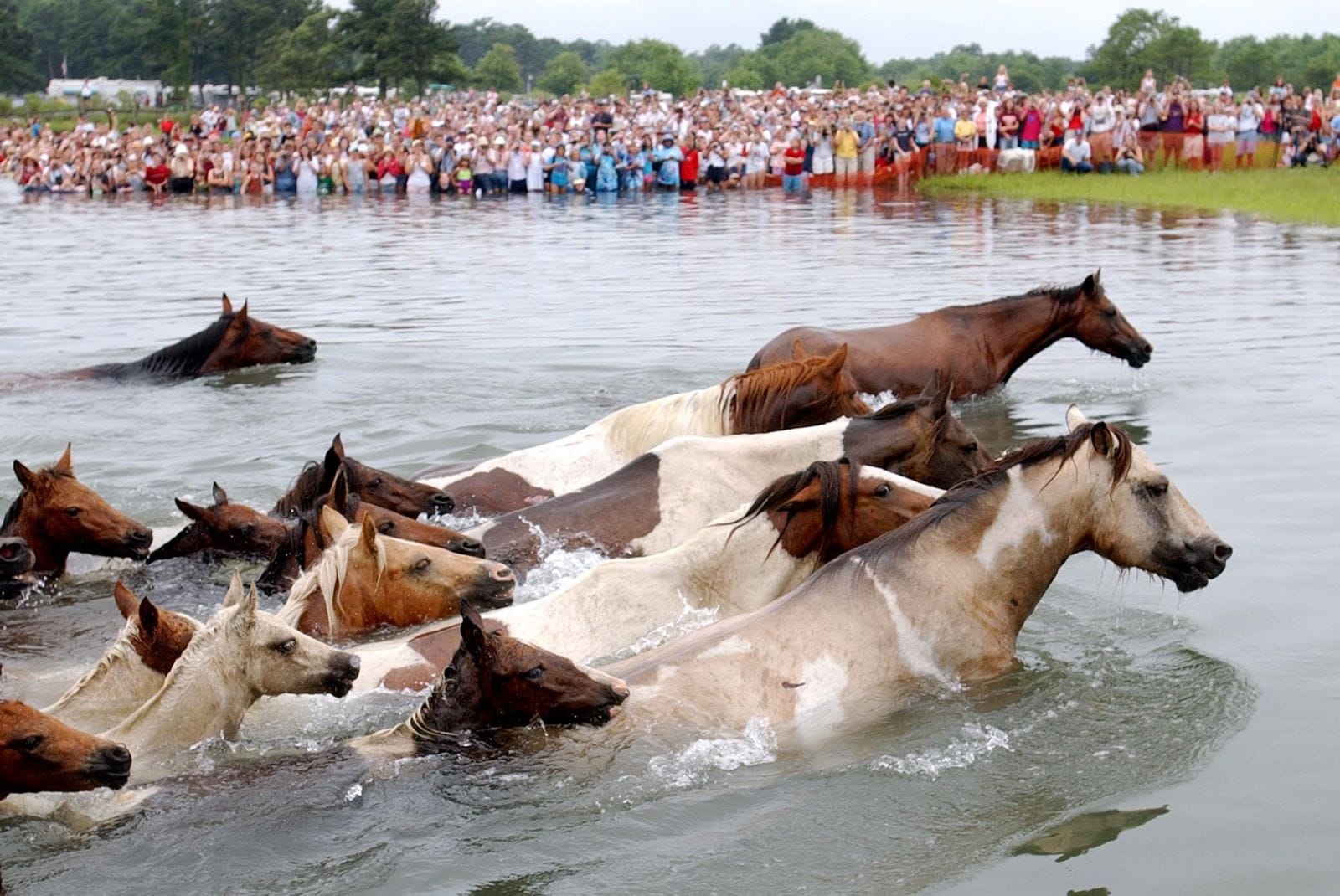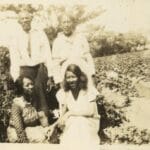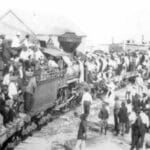Hey there, history buffs! Ever heard of Chincoteague Island? This gem off the Virginia coast is steeped in history, from its Native American roots to its present-day charm. Join us as we journey through time, uncovering the captivating story of Chincoteague Island – a tale of wild horses, resilient communities, and the enduring power of the sea.
History of Chincoteague Island
Imagine an island bathed in sunshine and the salty spray of the Atlantic, where wild horses roam free. That’s Chincoteague Island, a slice of paradise nestled along Virginia’s Eastern Shore. Its history is a captivating blend of Native American traditions, the aspirations of early colonists, and the unwavering spirit of a community shaped by the sea.
Long before European ships arrived, the Chincoteague people called this island home. Their name, echoing through the ages, speaks to their profound connection with this land. While records are scarce, we can envision their lives lived in harmony with nature, fishing its abundant waters and cultivating the land.
The dawn of the 17th century brought European settlers, forever altering the island’s delicate ecosystem. This marked a pivotal moment in Chincoteague’s story, introducing new challenges and opportunities.
The tumultuous American Civil War saw Chincoteague caught in the crossfire. Its strategic location and reliance on the sea made it a valuable prize, and its people were torn between loyalties to Virginia and the Union. This trying period left an indelible mark on the island’s soul.
Post-war, Chincoteague’s residents rebuilt their lives, and the oyster trade emerged as a lifeline, breathing economic life back into the island. People were drawn to Chincoteague, enticed by the promise of a fresh start and the bounty of the sea.
The early 1900s brought about a monumental change – the construction of a bridge connecting Chincoteague to the mainland. This wasn’t merely a bridge; it was a gateway to a new era. Tourists, captivated by the island’s untouched beauty and distinct charm, began to visit in droves.
Today, Chincoteague Island remains a place where the past harmoniously coexists with the present. Its historic landmarks, from quaint cottages to weathered docks, whisper tales of bygone eras. And of course, there are the legendary Chincoteague ponies, those wild and beautiful creatures that have captured hearts for generations, their hooves beating a timeless rhythm across the sandy beaches.
The story of Chincoteague Island continues to unfold. Through dedicated preservation efforts and the unwavering spirit of its people, the island’s rich tapestry of history continues to captivate and inspire. It’s a place where visitors can step back in time, reconnect with nature, and experience the magic that happens when the past and present intertwine.
Key Points from the History of Chincoteague Island:
- Pre-European History: Populated by the Chincoteague people, who lived in harmony with the land.
- 17th Century: European settlers arrived, bringing changes to the island.
- American Civil War: The island’s strategic location made it a contested prize.
- Post-Civil War Prosperity: The oyster trade boomed, fueling economic growth.
- Early 20th Century: Construction of a causeway connected the island to the mainland, leading to an influx of tourists.
- Seafood Industry: Oysters and clams have been the lifeblood of the island’s economy for centuries.
- Tourism: Chincoteague’s wild beauty and unique charm attracted visitors starting in the 1920s.
- Historical Landmarks: Preserved landmarks, such as cottages and docks, offer a glimpse into the island’s past.
- Chincoteague Ponies: Wild horses roaming the island are a legendary attraction.
- Continuing Story: The island’s history continues to be shaped by preservation efforts and the enduring spirit of its community.
Key Lines:
- Chincoteague Island, named for the Native American phrase meaning “beautiful land across the water,” has a rich history dating back centuries.
- European settlement began in the 17th century, with the island granted to a Virginia colonist in 1650 and later becoming a colonial settlement.
- The modern era of Chincoteague Island commenced in 1908 with its incorporation as a town within Accomack County, followed by the completion of a causeway in 1922.
- Chincoteague Island’s history is intertwined with the oyster trade, Native American presence, and the Civil War, shaping its unique character and heritage.
What is the history of Chincoteague Island?
European settlers arrived in the 17th century, leaving a lasting impact on the island’s delicate ecosystem. This marked a turning point in Chincoteague’s story, bringing both challenges and opportunities.
During the American Civil War, Chincoteague’s strategic location made it a sought-after prize. This was a trying time for the island’s inhabitants, torn between their loyalty to Virginia and the Union.
As the war ended, Chincoteague’s residents focused on rebuilding. The oyster trade became a lifeline, bringing much-needed economic prosperity. People were drawn to the island, seeking a fresh start and the abundance of the sea.
The early 20th century ushered in a new era with the construction of a bridge connecting Chincoteague to the mainland. This opened the door to tourism, forever changing the island’s identity. Tourists flocked to Chincoteague, eager to experience its unspoiled beauty and unique charm.
Today, Chincoteague Island is a cherished vacation destination, attracting visitors from all walks of life. Remnants of its past are still visible today – in the picturesque cottages that whisper tales of bygone eras and the weathered docks that have borne witness to countless tides. And then there are the legendary Chincoteague ponies, those wild spirits roaming freely among the sandy dunes, a testament to the island’s untamed beauty.
Here’s a glimpse into Chincoteague’s remarkable journey:
| Era | Event | Significance |
|---|---|---|
| Before the 17th Century | Native American inhabitation | Shaped the island’s deep connection to nature |
| 17th Century | Arrival of European settlers | Introduced new challenges and opportunities to the island’s ecosystem |
| 19th Century | American Civil War | Tested the resilience of the island and its people |
| Late 19th Century | Rise of the oyster trade | Fueled economic prosperity and attracted new residents |
| Early 20th Century | Construction of a causeway connecting the island to the mainland | Opened Chincoteague to tourism, transforming its identity |
The story of Chincoteague Island is far from over. Historians and archaeologists are still piecing together its fascinating past. New discoveries may reveal even more about the island’s earliest inhabitants, the impact of European settlement, and the lasting legacy of its maritime heritage.
So, the next time you’re on Chincoteague Island, take a moment to soak it all in. You might just hear whispers of the past carried on the salty breeze.
Want to delve deeper? Visit the Chincoteague Island Museum or embark on a guided walking tour to uncover more about this remarkable place!
How did wild horses get to Chincoteague?
The wild horses of Chincoteague Island are a captivating sight, but their origins remain shrouded in mystery. While no definitive answer exists, several compelling theories have emerged over the years.
One enduring theory suggests that the horses are descendants of Spanish horses that survived a shipwreck off the Virginia coast in the 16th century. Imagine a ship going down, its equine passengers bravely swimming ashore to establish a new home on Chincoteague. This dramatic tale has been passed down for generations, capturing the imagination of locals and visitors alike.
Another popular theory involves pirates. Some believe that pirates, known to frequent these waters, abandoned their horses on the island, leaving them to adapt to the wild. This theory gains traction from the fact that Chincoteague ponies are relatively small, similar to the Andalusian horses favored by Spanish explorers and, yes, pirates.
The National Park Service, however, favors a different explanation. They propose that early settlers brought the horses to Chincoteague in the 17th century. Their reasoning stems from the presence of European breed traces in the ponies’ genes, suggesting a link to horses brought over by settlers.
So, which theory holds the key to the Chincoteague ponies’ origins? The debate continues! Scientists are employing DNA testing to unravel this mystery. By comparing their DNA to that of Spanish and European horses, they hope to pinpoint their ancestry and finally settle the debate.
It’s fascinating that even in this modern age, the secrets of these incredible animals are still being uncovered. Regardless of whether they descended from shipwreck survivors, were abandoned by pirates, or arrived with settlers, the Chincoteague ponies stand as a testament to resilience and adaptation. Their story is a reminder of the enduring mysteries woven into the fabric of history.
What does the siren on Chincoteague Island mean?
Life on an island may seem tranquil, but even in a place as charming as Chincoteague, the sound of a siren can instantly grab your attention. So, what does it signify when that piercing sound cuts through the air?
In most cases, the siren likely signals a fire alarm, alerting the brave members of the Chincoteague Volunteer Fire Company to a potential blaze on the island. With its mix of residences, businesses, and natural areas, fire is a risk, and the siren serves as a crucial component of the island’s safety net.
However, the siren could also be a harbinger of approaching severe weather. Coastal regions like Chincoteague are vulnerable to sudden storms, particularly during hurricane season. When the skies darken, and the wind picks up, that siren could be warning residents and visitors to seek shelter and brace for impact.
While less common, the siren might also indicate other emergencies, such as a boating accident requiring the Coast Guard’s immediate response. While Chincoteague’s waters are undoubtedly beautiful, they can also be unpredictable, and maritime emergencies, unfortunately, do occur.
While context can provide clues about the siren’s meaning, the most accurate information can often be found by checking local radio stations or official sources, such as the Chincoteague Volunteer Fire Company’s social media pages.
So, the next time the siren wails on Chincoteague Island, remember that it’s a call to attention, a reminder that even in paradise, a healthy dose of awareness is always wise.
What is the purpose of the pony swim at Chincoteague Island?
The Pony Swim at Chincoteague Island isn’t just a captivating spectacle; it’s a tradition spanning over a century, showcasing the island’s deep connection with its wild inhabitants. Every year, a herd of wild ponies bravely navigates the Assateague Channel, guided by skilled horseback riders, offering a glimpse into the island’s untamed spirit.
One of the primary reasons behind this annual event is to celebrate the island’s famous wild ponies. These remarkable creatures, known for their resilience and beauty, have roamed freely on the island for centuries. The swim offers a unique opportunity to witness their strength and swimming prowess firsthand, reminding us of their indomitable spirit.
Beyond the celebration, the Pony Swim plays a vital role in supporting the Chincoteague Volunteer Fire Company. Serving as a major fundraiser, the event generates crucial funds that keep the fire department operational, ensuring the safety and well-being of the island community.
But why subject the ponies to this annual swim? The answer lies in the importance of maintaining a balanced ecosystem on Assateague Island. Without natural predators, the pony population could easily outgrow the island’s resources. The swim helps manage the herd size, preventing overgrazing and preserving the delicate balance of this fragile environment.
In essence, the Pony Swim is a testament to the island’s commitment to respecting both the ponies and their environment. It allows us to marvel at their wild beauty while ensuring their well-being and the health of their island home.
The Pony Swim is more than just an event; it’s a window into the heart of Chincoteague Island. Attracting visitors from all walks of life, it embodies the island’s maritime legacy and vibrant culture. It serves as a powerful reminder of the enduring connection between humans, animals, and the shared environment.
Key Takeaways:
- The Pony Swim is a tribute to the Chincoteague wild ponies, showcasing their strength and spirit.
- It’s a vital fundraiser that supports the Chincoteague Volunteer Fire Company, ensuring the island’s safety.
- The swim plays a crucial role in managing the pony population, keeping Assateague Island’s ecosystem healthy.
- It’s a cherished tradition that embodies Chincoteague Island’s rich maritime heritage and draws visitors from all corners.
Why do they sell the Chincoteague Ponies?
The annual Pony Penning on Chincoteague Island culminates in a tradition that often raises questions: the auctioning of some of the beloved ponies. This practice, deeply rooted in the island’s history, serves both practical and financial purposes.
Perhaps the most significant reason behind the auction is its role in supporting the Chincoteague Volunteer Fire Company. The event serves as their largest fundraiser, generating crucial revenue that enables them to continue providing vital emergency services to the island community.
The auction also plays a vital role in maintaining a healthy pony population on Assateague Island. Without natural predators to regulate their numbers, the ponies could overgraze and strain the island’s delicate ecosystem. By carefully managing the herd size through the auction, the Chincoteague community ensures the long-term well-being of both the ponies and their island home.
The fame of the Chincoteague ponies, particularly Misty, immortalized in Marguerite Henry’s beloved books and film adaptation, has brought increased attention and conservation efforts to the breed. This focus on their well-being highlights the importance of responsible herd management.
Interestingly, recent research into the ponies’ genetics suggests a potentially more complex ancestry than previously thought. While the popular shipwreck origin story persists, some evidence suggests that Native American ponies may have played a role in their lineage. Ongoing studies continue to unravel the mysteries surrounding the breed’s past.
The auction, therefore, is not merely a tradition; it’s a carefully considered practice that contributes to the financial stability of the fire company and the long-term health of the Chincoteague pony population. It’s a testament to the island’s commitment to balancing tradition with the needs of both the community and the ponies themselves.
Why do they move the Chincoteague Ponies?
The annual spectacle of the Chincoteague ponies swimming from Assateague Island to Chincoteague might seem unusual at first glance, but this tradition, practiced for nearly a century, serves several vital purposes.
First and foremost, the swim is a form of population control. Imagine a group of ponies confined to a limited space. Without intervention, their numbers would grow unchecked, placing a strain on the island’s resources. The Pony Penning and Swim, expertly managed by the “Saltwater Cowboys,” ensures the herd remains at a sustainable size, protecting both the ponies and their environment.
The swim also offers an opportunity to find new homes for some of the younger ponies. While it may seem bittersweet, the auctioning of these ponies benefits both the animals and the community. The funds raised go directly to the Chincoteague Volunteer Fire Company, providing them with essential resources to safeguard the island. In turn, the ponies find loving homes, ensuring their continued well-being.
But the Pony Penning & Swim is much more than a practical event. It’s a cherished tradition that strengthens community bonds and draws visitors from far and wide. People gather to witness this remarkable display of horsemanship and community spirit, connecting with a practice that embodies the island’s maritime history and vibrant culture.
The swim serves as a powerful reminder of the interconnectedness of humans, animals, and the environment. It’s a testament to the careful balance required to ensure the well-being of both the Chincoteague ponies and the island they call home.
Why do the ponies travel from Assateague Island to Chincoteague Island?
Every year, the famous Chincoteague ponies make their way from Assateague Island to Chincoteague, creating a captivating spectacle that has become synonymous with the islands themselves. While we can’t ask the ponies directly, several compelling theories offer insights into the reasons behind this annual journey.
One likely factor is diet. While both islands are beautiful, the grasses on Chincoteague are richer in certain nutrients that may be lacking in Assateague’s vegetation. This annual migration could be the ponies’ way of supplementing their diet, ensuring they receive the essential nutrients needed for optimal health.
Another possibility lies in the realm of pony romance. Assateague’s stallions are known to be fiercely protective of their mares. The swim to Chincoteague provides an opportunity for the ponies to interact with a wider pool of potential mates, promoting genetic diversity within the herd.
Finally, the harsh winters off the coast may also play a role. Assateague, exposed to the full force of the elements, can experience biting winds and frigid temperatures. Chincoteague, on the other hand, offers a degree of protection from the harshest weather. This suggests that the ponies may instinctively seek a more hospitable environment during the colder months.
While these are just theories, they highlight the complex interplay of factors that likely influence the ponies’ annual swim. It’s a testament to their adaptability and survival instincts, reminding us that even a seemingly simple act like a swim can hold profound significance in the natural world.
What does “teague” mean in Chincoteague?
The name “Chincoteague” itself holds a clue to the island’s past, specifically the intriguing “teague” part. It’s not just a catchy sound; it’s a linguistic link to the island’s first inhabitants.
“Teague” comes from the language of the Native Americans who were the original stewards of this land. The name “Chincoteague” translates to “Beautiful Land Across the Water,” a fitting description for an island known for its stunning coastline and separation from the mainland. It’s remarkable how a single word can encapsulate the essence of a place so beautifully.
For centuries, the island has been known by the name bestowed upon it by its first residents, a powerful reminder of their enduring legacy.
While “Beautiful Land Across the Water” is the widely accepted translation, it’s essential to remember that languages evolve, and interpretations can shift over time. Some linguists suggest that variations in dialect and the passage of time might mean the original meaning held subtler nuances. Ongoing research into Native American languages could uncover even richer layers of meaning behind the name “Chincoteague,” reminding us that there’s always more to learn about the past.
What Happens to Chincoteague Ponies?
The life of a Chincoteague pony may seem idyllic, with its wild freedom and island home. However, these tough little horses don’t simply roam freely on Assateague Island; their lives are carefully managed to ensure their well-being and the health of the island’s fragile ecosystem.
The Swim That Captures Hearts
Every year, usually in July, the Chincoteague ponies inhabiting the Virginia side of Assateague Island participate in the captivating Pony Swim. This event, attracting crowds from far and wide, involves the ponies being rounded up by the Saltwater Cowboys – members of the Chincoteague Volunteer Fire Company dedicated to the ponies’ care. In a scene that seems straight out of a storybook, the ponies are then guided across a narrow channel to neighboring Chincoteague Island.
More Than Just a Show
While visually stunning, the Pony Swim is much more than just a spectacle. It’s a vital tool for managing the pony population. Without natural predators, the ponies could easily overgraze, damaging both their habitat and their own long-term survival.
Auctioning for a Good Cause
After the excitement of the swim subsides, some of the younger ponies are auctioned off to new homes. This practice helps maintain a sustainable pony population and serves as a significant fundraiser for the Chincoteague Volunteer Fire Company, ensuring they have the resources to continue safeguarding the island and its inhabitants.
Facing Challenges, Embracing the Future
Like many wild animal populations, Chincoteague ponies face challenges such as habitat loss, disease, and the impacts of climate change. However, they have passionate advocates on their side. Organizations like the National Park Service, which manages the Maryland part of Assateague Island, and the Chincoteague Volunteer Fire Company are dedicated to protecting these unique animals.
A Legacy of Resilience
The Chincoteague ponies are more than just horses; they’re symbols of resilience, adaptation, and the remarkable bond between humans and animals. While the future may hold uncertainties, one thing remains certain: as long as people continue to care for and respect these incredible creatures, the legacy of the Chincoteague ponies will endure.
What is the difference between Assateague and Chincoteague?
Planning a trip to the Eastern Shore? You’re likely to encounter the names Assateague and Chincoteague – two beautiful islands located just a short distance from each other. While easy to confuse, these islands possess distinct personalities that set them apart.
Assateague is for the adventurers, the nature lovers who relish unspoiled beauty. Picture wild, windswept beaches, rolling dunes, and the opportunity to spot the famous wild horses roaming freely. While you won’t find lavish resorts on Assateague, you will find tranquility and a deep connection with nature. The National Park Service oversees this island, diligently working to preserve its wild character.
Chincoteague, on the other hand, offers a livelier atmosphere. While stunning beaches are still a given, Chincoteague also boasts charming shops, inviting restaurants, and cozy accommodations. This family-friendly destination has a long history of welcoming visitors and is managed by the town of Chincoteague.
Both islands are accessible from the mainland via bridges, with Assateague stretching further and occupying both Maryland and Virginia. Chincoteague, situated south of Assateague, requires a short drive over the mainland to reach.
Here’s a quick comparison to highlight their differences:
| Feature | Assateague Island | Chincoteague Island |
|---|---|---|
| Vibe | Untamed natural beauty, focus on preservation | Charming island town, lively atmosphere |
| Development | Largely undeveloped | Developed infrastructure, tourism amenities |
| Management | National Park Service | Town of Chincoteague |
| Best for | Nature lovers, solitude seekers, wildlife enthusiasts | Families, history buffs, seafood enthusiasts |
Whether you choose the wild beauty of Assateague or the charming atmosphere of Chincoteague, an unforgettable experience amidst stunning scenery awaits.
To explore more about the captivating world of history and design, check out these fascinating links:
- Journey through the evolution of furniture with this insightful exploration of the history of chairs at Georgia Tech.
- Uncover the captivating story of Los Angeles’ Chavez Ravine and its transformation in this detailed account of its history.
- For typography enthusiasts, this deep dive into the history of the Clarendon typeface reveals its enduring impact on printing and design.
- Immerse yourself in the rich traditions of Native American crafts by delving into the history of corn husk dolls.
- Unveiling the Enigma: Mansoureh Khojasteh Bagherzadeh’s Public Appearances & Private Life in Iran - July 18, 2025
- Unveiling the Mystery: Mansoureh Khojasteh Bagherzadeh’s Husband: A Rare Glimpse into a Private Life - July 18, 2025
- Unveiling Masoud Khamenei’s Mother: Power, Influence, and Iran’s Future - July 18, 2025
















